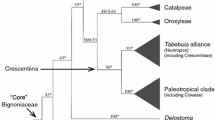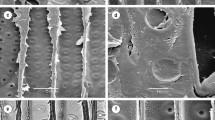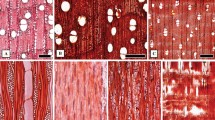Abstract
Our main goals were to identify diagnostic characters at the species, genus, and subfamily levels, find anatomical features with potential for future morphological and molecular (combined) phylogenetic analyses, and to reconstruct the evolution of wood anatomical characters in two subfamilies of Primulaceae in a molecular phylogenetic framework. We investigated twenty-seven species from the woody Myrsinoideae (4 genera) and Theophrastoideae (2 genera) using scanning electron, light, and epifluorescence microscopy. Samples were prepared using standard protocols. Based on the wood anatomical characters, we were able to identify synapomorphies and to detect evolutionary trends of interest for the genera and subfamilies. Both subfamilies share the presence of diffuse porosity, simple perforation plates, septate fibres, and scanty paratracheal axial parenchyma. Theophrastoideae species have rays > 10 cells wide and short (< 350 µm) vessel elements, and Myrsinoideae have breakdown areas in rays and longer vessel elements. Ardisia and Stylogyne have scalariform intervessel pits, Myrsine exhibit breakdown areas in rays, and two Cybianthus species from subgenus Weilgetia have distinguishing features (e.g., scalariform perforation plate in C. nemoralis and the absence of rays in C. densiflorus). Overall, when combining characters, we were able to segregate the Neotropical Primulaceae subfamilies and genera from each other and from the subfamily Maesoideae based on wood anatomy.









Similar content being viewed by others
References
Agostini G (1980) Una nueva clasificación del género Cybianthus (Myrsinaceae). Acta Bot Venez 10:129–185
Anderberg AA, Ståhl B (1995) Phylogenetic interrelationships in the order Primulales, with special emphasis on the family circumscriptions. Canad J Bot 73:1699–1730. https://doi.org/10.1139/b95-184
Anderberg AA, Ståhl B, Källersjö M (1998) Phylogenetic relationships in the Primulales inferred from rbcL sequence data. Pl Syst Evol 211:93–102. https://doi.org/10.1007/BF00984914
Anderberg AA, Ståhl B, Kallersjö M (2000) Maesaceae, a new primuloid family in the order Ericales s.l. Taxon 49:183–187. https://doi.org/10.2307/1223834
Anderberg AA, Peng CI, Trift I, Kallersjö M (2001) The Stimpsonia problem: evidence from DNA sequences of plastid genes atpB, ndhF and rbcL. Bot Jahrb Syst 123:369–376
APG III (Angiosperm Phylogeny Group) (2009) An update of the Angiosperm Phylogeny Group classification for the orders and families of flowering plants. Bot J Linn Soc 161:105–161. https://doi.org/10.1111/j.1095-8339.2009.00996.x
APG IV (Angiosperm Phylogeny Group) (2016) An update of the Angiosperm Phylogeny Group classification for the orders and families of flowering plants: APG IV. Bot J Linn Soc 181:1–20. https://doi.org/10.1111/boj.12385
Baas P (1982) Systematic, phylogenetic, and ecological wood anatomy—history and perspectives. In: Baas P (ed) New perspectives in wood anatomy. Forestry sciences, vol. 1. Springer, Dordrecht, pp 23–58. https://doi.org/10.1007/978-94-017-2418-0_2
Baas P, Wheeler E, Chase M (2000) Dicotyledonous wood anatomy and the APG system of angiosperm classification. Bot J Linn Soc 134:3–17. https://doi.org/10.1111/j.1095-8339.2000.tb02343.x
Bailey IW (1944) The development of vessels in angiosperms and its significance in morphological research. Amer J Bot 31:421–428. https://doi.org/10.2307/2437302
BFG (The Brazil Flora Group) (2015) Growing knowledge: an overview of Seed Plant diversity in Brazil. Rodriguésia 66:1085–1113. https://doi.org/10.1590/2175-7860201566411
Bukatsch F (1972) Bemerkungen zur doppelfärbung astrablau-safranin. Mikrokosmos 61:33–36
Carlquist S (1974) Island biology. Columbia University Press, New York
Carlquist S (1992) Wood anatomy of sympetalous dicotyledon families: a summary, with comments on systematic relationships and evolution of the woody habit. Ann Missouri Bot Gard 79:303–332. https://doi.org/10.2307/2399771
Carlquist S (2001) Comparative wood anatomy, 2nd edn. Springer, Berlin. https://doi.org/10.1007/978-3-662-04578-7
Carlquist S (2012) How wood evolves: a new synthesis. Botany 90:901–940. https://doi.org/10.1139/b2012-048
Carlquist S (2013) More woodiness/less woodiness: evolutionary avenues, ontogenetic mechanisms. Int J Pl Sci 174:964–991. https://doi.org/10.1086/670400
Carlquist S (2015a) Living cells in wood. 1. Absence, scarcity and histology of axial parenchyma as keys to function. Bot J Linn Soc 174:291–321. https://doi.org/10.1111/boj.12247
Carlquist S (2015b) Living cells in wood. 2. Raylessness: histology and evolutionary significance. Bot J Linn Soc 178:529–555. https://doi.org/10.1111/boj.12291
Committee IAWA (1989) IAWA list of microscopic features for hardwood identification. IAWA Bull 10:219–332
Dayal R, Rao V, Sharma B (1984) Perforated ray cells in woods of Indian Myrsinaceae and Loganiaceae. IAWA Bull 5:225–228. https://doi.org/10.1163/22941932-90000895
Franklin GL (1945) Preparation of thin sections of synthetic resins and wood–resin composites, and a new macerating method for wood. Nature 155:51. https://doi.org/10.1038/155051a0
Ilic J (1987) The CSIRO family key for hardwood identification, vol. 8. Brill Archive, Leiden
Johansen DA (1940) Plant microtechnique. McGraw-Hill Book Company, New York
Källersjö M, Bergqvist G, Anderberg AA (2000) Generic realignment in primuloid families of the Ericales s.l.: a phylogenetic analysis based on DNA sequences from three chloroplast genes and morphology. Amer J Bot 87:1325–1341. https://doi.org/10.2307/2656725
Kukachka BF (1981) Wood Anatomy of the neotropical Sapotaceae: XX. Manilkara. US Department of Agriculture, Madison
Lens F, Jansen S, Caris P, Serlet L, Smets E (2005a) Comparative wood anatomy of the primuloid clade. Syst Bot 30:162–182. https://doi.org/10.1600/0363644053661922
Lens F, Dressler S, Jansen S, Van Evelghem L, Smets E (2005b) The relationships within balsaminoid Ericales: a wood anatomical approach. Amer J Bot 92:941–953. https://doi.org/10.3732/ajb.92.6.941
Lens F, Schönenberger J, Baas P, Jansen S, Smets E (2007) The role of wood anatomy in phylogeny reconstruction of Ericales. Cladistics 23:229–254. https://doi.org/10.1111/j.1096-0031.2006.00142.x
Lens F, Vos R, Charrier G, van der Niet T, Merckx V, Baas P, Aguirre Gutierrez J, Jacobs B, Chacon-Dória L, Smets E, Delzon S, Janssens S (2016) Scalariform-to-simple transition in vessel perforation plates triggered by differences in climate during the evolution of Adoxaceae. Ann Bot (Oxford) 118:1043–1056. https://doi.org/10.1093/aob/mcw151
Ludwig JA, Reynolds JF (1988) Statistical ecology: a primer on methods and computing. Wiley, New York
Luna BN, Defaveri ACA, Sato A, Bizzo HR, Freitas MF, Barros CF (2014) Leaf secretory tissues in Myrsine coriacea and Myrsine venosa (Primulaceae): ontogeny, morphology, and chemical composition of essential oils. Botany 92:757–766. https://doi.org/10.1139/cjb-2014-0044
Luna BN, Freitas MF, Baas P, De Toni KLG, Barros CF (2017) Leaf anatomy of five Neotropical genera of Primulaceae. Int J Pl Sci 178:362–377. https://doi.org/10.1086/691213
Maddison WP, Maddison DR (2017) Mesquite: a modular system for evolutionary analysis. Version 3.2. Available at: http://mesquiteproject.org. Accessed 4 Mar 2018
Metcalfe CR, Chalk L (1950) Anatomy of the dicotyledons, vol. 2. Oxford Claredon Press, Oxford
Olson ME (2005) Commentary: typology, homology, and homoplasy in comparative wood anatomy. IAWA J 26:507–522. https://doi.org/10.1163/22941932-90000131
Otegui MS (1994) Occurrence of perforated ray cells and ray splitting in Rapanea laetevirens and R. lorentziana (Myrsinaceae) rays. IAWA J 15:257–263. https://doi.org/10.1163/22941932-90000605
Otegui M, Cocucci A (1999) Flower morphology and biology of Myrsine laetevirens, structural and evolutionary implications of anemophily in Myrsinaceae. Nordic J Bot 19:71–85. https://doi.org/10.1111/j.1756-1051.1999.tb01904.x
Otegui MS, Gaspar ML, Maldonado S, Varetti EL, Pollero R (1998) Studies on tissues associated to hydrobenzoquinone secretion in Myrsine laetevirens (Myrsinaceae). Nordic J Bot 18:447–459. https://doi.org/10.1111/j.1756-1051.1998.tb01522.x
Pérez Olvera CP, Valdovinos TFC, Gómez MAR (1980) Estudio anatomico de la Madera de 43 especies tropicales. Instituto nacional de Investigaciones Forestales, México
Pipoly JJ III (1987) A systematic revision of the genus Cybianthus subgenus Grammadenia (Myrsinaceae). Mem New York Bot Gard 43:1–76
Schönenberger J, Anderberg AA, Sytsma KJ (2005) Molecular phylogenetics and patterns of floral evolution in the Ericales. Int J Pl Sci 166:265–288. https://doi.org/10.1086/427198
Sonsin JO, Gasson P, Machado SR, Caum C, Marcati CR (2014) Atlas of wood diversity in the Cerrado of São Paulo. Fundação de Estudos e Pesquisas Agrícolas e Florestais (FEPAF), Botucatu
Stevens PF (2001 onwards) Angiosperm phylogeny website, version 12, July 2012. Available at: http://www.mobot.org/MOBOT/research/APweb/. Accessed 4 Mar 2018
Strasburger E (1924) Handbook of practical botany, 8th edn. George Allen & Unwin, London
Acknowledgements
We thank the Coordenação de Aperfeiçoamento de Pessoal de Nível Superior (CAPES) and Fundação de Amparo à Pesquisa do Estado do Rio de Janeiro (FAPERJ) for financial support. C.F.B. received grants from the Conselho Nacional de Desenvolvimento Científico e Tecnológico (CNPq). We thank Zeiss for the opportunity to use the Axio Imager 2 equipment. We also thank anonymous reviewers for their valuable feedback.
Author information
Authors and Affiliations
Corresponding author
Ethics declarations
Conflict of interest
The authors declare that they have no conflict of interest.
Additional information
Handling editor: Mike Thiv.
Electronic supplementary material
Below is the link to the electronic supplementary material.
Online Resource 1
Matrix of wood anatomical characters used in the PCA. Data obtained from the present work and from Lens et al. (2005a). (PDF 555 kb)
Information on Electronic Supplementary Material
Information on Electronic Supplementary Material
Online Resource 1. Matrix of wood anatomical characters used in the PCA. Data obtained from the present work and from Lens et al. (2005a).
Rights and permissions
About this article
Cite this article
de Luna, B.N., Freitas, M.F. & Barros, C.F. Systematic and phylogenetic implications of the wood anatomy of six Neotropical genera of Primulaceae. Plant Syst Evol 304, 775–791 (2018). https://doi.org/10.1007/s00606-018-1509-0
Received:
Accepted:
Published:
Issue Date:
DOI: https://doi.org/10.1007/s00606-018-1509-0




